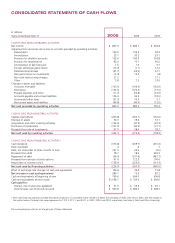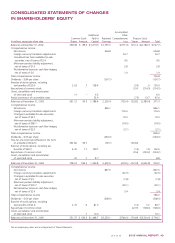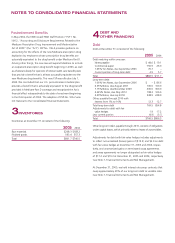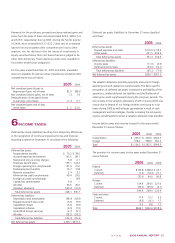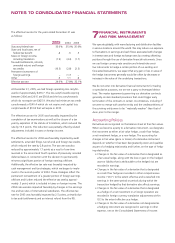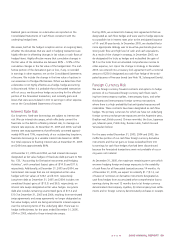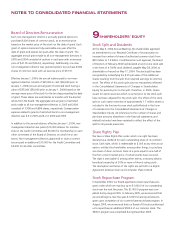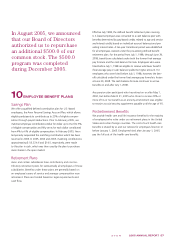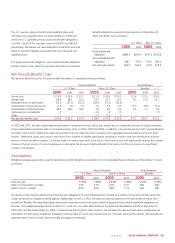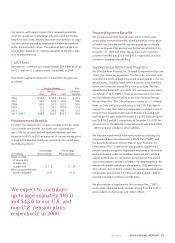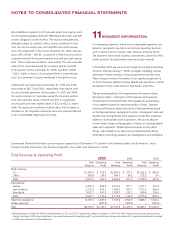Avon 2005 Annual Report Download - page 32
Download and view the complete annual report
Please find page 32 of the 2005 Avon annual report below. You can navigate through the pages in the report by either clicking on the pages listed below, or by using the keyword search tool below to find specific information within the annual report.
NOTESTOCONSOLIDATEDFINANCIALSTATEMENTS
The effective tax rate for the years ended December 31 was
as follows:
2005 2004 2003
Statutory federal rate 35.0% 35.0% 35.0%
State and local taxes, net of
federal tax benefit .8 .6 .5
Taxes on foreign income,
including translation (1.9) (4.4) (1.7)
Tax audit settlements, refunds,
amended returns and foreign
tax credits (10.5) (2.8) (2.5)
Permanent investment of
foreign earnings – (1.7) –
Other .6 1.1 .8
Effective tax rate 24.0% 27.8% 32.1%
At December 31, 2005, we had foreign operating loss carryfor-
wards of approximately $476.7. The loss carryforwards expiring
between 2006 and 2015 are $50.8 and the loss carryforwards
which do not expire are $425.9. We also had minimum tax credit
carryforwards of $40.4 which do not expire and capital loss
carryforwards of $10.8 that will expire in 2010.
The effective tax rate for 2005 was favorably impacted by the
completion of tax examinations as well as the closure of a tax
year by expiration of the statute of limitations, which reduced the
rate by 10.5 points. This reduction was partially offset by related
adjustments included in taxes on foreign income.
The effective tax rate for 2004 was favorably impacted by audit
settlements, amended filings, tax refunds and foreign tax credits,
which reduced the rate by 2.8 points. The tax rate was also
reduced by approximately 1.7 points as a result of one-time
reversals in the second and fourth quarters of previously recorded
deferred taxes in connection with the decision to permanently
reinvest a significant portion of foreign earnings offshore.
Additionally, the effective tax rate was favorably impacted by
cash management and tax strategies, which we began to imple-
ment in the second quarter of 2004. These strategies reflect the
permanent reinvestment of a greater portion of foreign earnings
offshore and further reduced the effective tax rate by approxi-
mately .5 point, which is included in taxes on foreign income. The
2004 rate was also impacted favorably by changes in the earnings
mix and tax rates of international subsidiaries. The effective tax
rate for 2003 was favorably impacted by 2.5 points, primarily due
to tax audit settlements and an interest refund from the IRS.
7FINANCIALINSTRUMENTS
ANDRISKMANAGEMENT
We operate globally, with manufacturing and distribution facilities
in various locations around the world. We may reduce our exposure
to fluctuations in earnings and cash flows associated with changes
in interest rates and foreign exchange rates by creating offsetting
positions through the use of derivative financial instruments. Since
we use foreign currency-rate sensitive and interest-rate sensi-
tive instruments to hedge a certain portion of our existing and
forecasted transactions, we expect that any gain or loss in value of
the hedge instruments generally would be offset by decreases or
increases in the value of the underlying transactions.
We do not enter into derivative financial instruments for trading
or speculative purposes, nor are we a party to leveraged deriva-
tives. The master agreements governing our derivative contracts
generally contain standard provisions that could trigger early
termination of the contracts in certain circumstances, including if
we were to merge with another entity and the creditworthiness of
the surviving entity were to be “materially weaker” than that of
Avon prior to the merger.
Accounting Policies
Derivatives are recognized on the balance sheet at their fair values.
When we become a party to a derivative instrument, we designate
the instrument as either a fair value hedge, a cash flow hedge,
a net investment hedge, or a non-hedge. The accounting for
changes in fair value (gains or losses) of a derivative instrument
depends on whether it has been designated by Avon and qualifies
as part of a hedging relationship and further, on the type of hedg-
ing relationship.
• Changes in the fair value of a derivative that is designated as
a fair value hedge, along with the loss or gain on the hedged
asset or liability that is attributable to the hedged risk are
recorded in earnings.
• Changes in the fair value of a derivative that is designated
as a cash flow hedge are recorded in other comprehensive
income (“OCI”) to the extent effective and reclassified into
earnings in the same period or periods during which the
transaction hedged by that derivative also affects earnings.
• Changes in the fair value of a derivative that is designated
as a hedge of a net investment in a foreign operation are
recorded in foreign currency translation adjustments within
OCI to the extent effective as a hedge.
• Changes in the fair value of a derivative not designated as
a hedging instrument are recognized in earnings in other
expense, net on the Consolidated Statements of Income.


